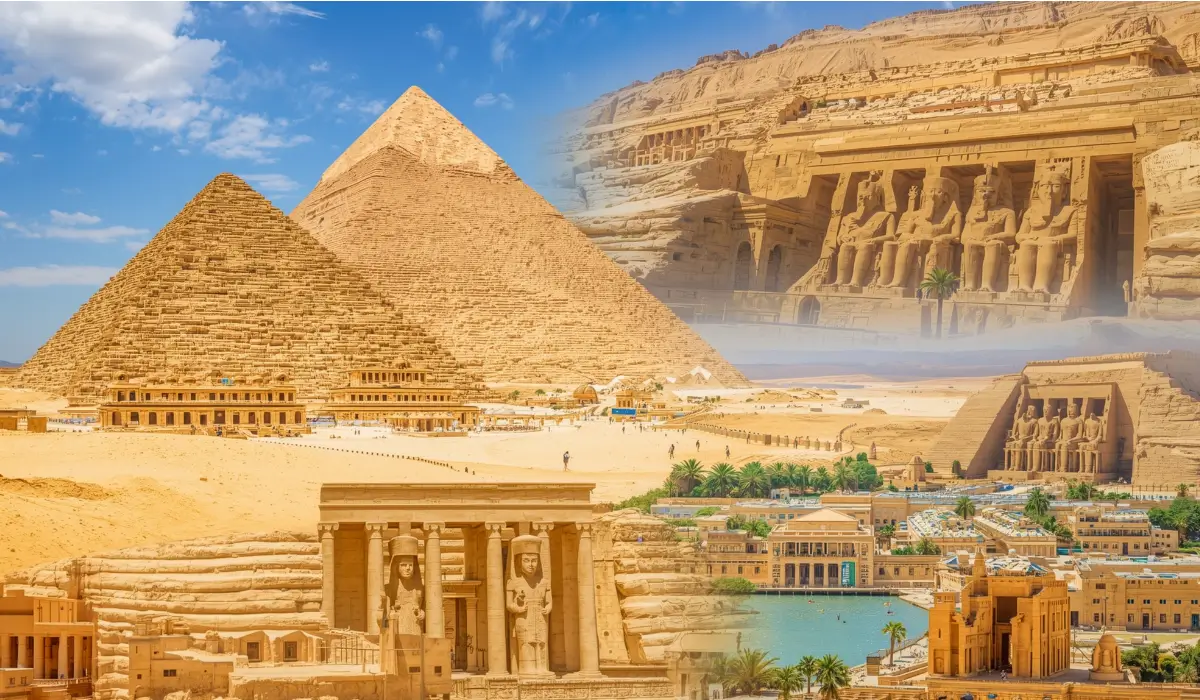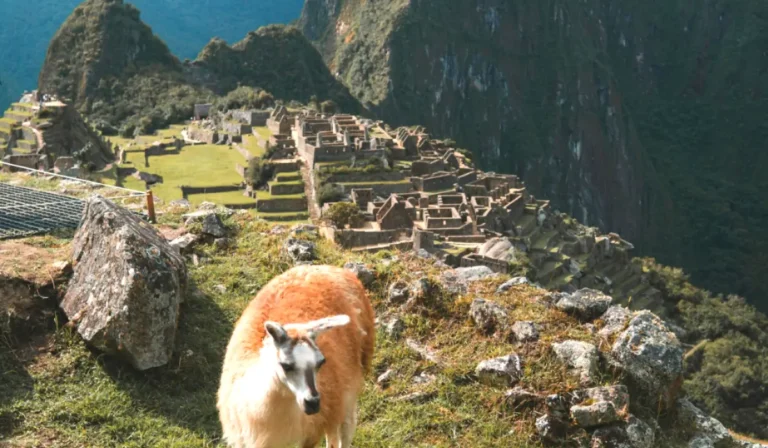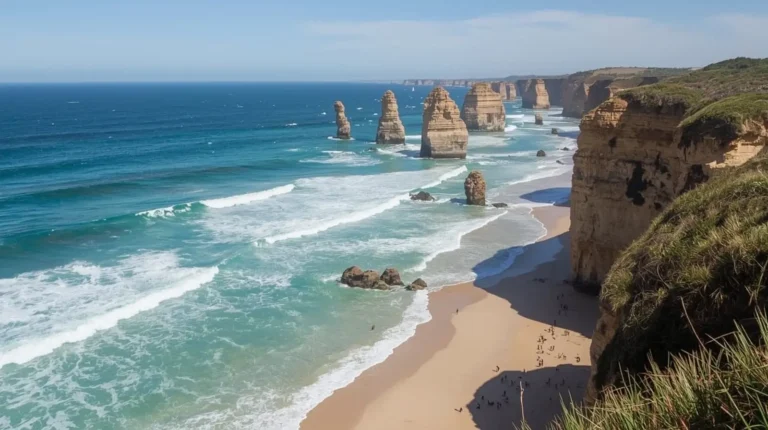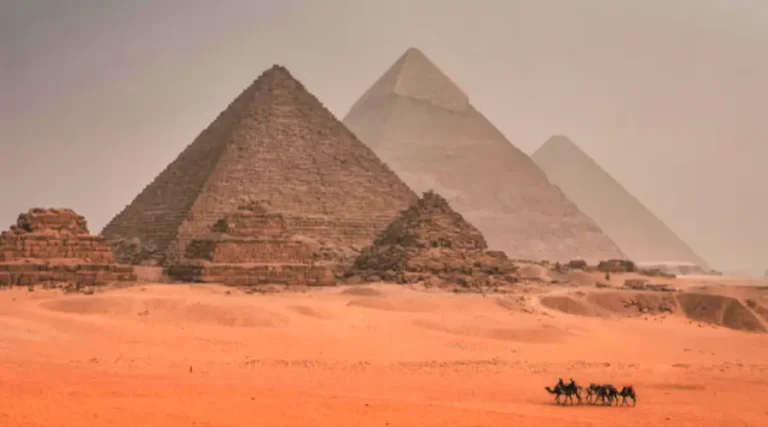10 Day Egypt Itinerary: Ultimate 2025 Guide with Insider Tips
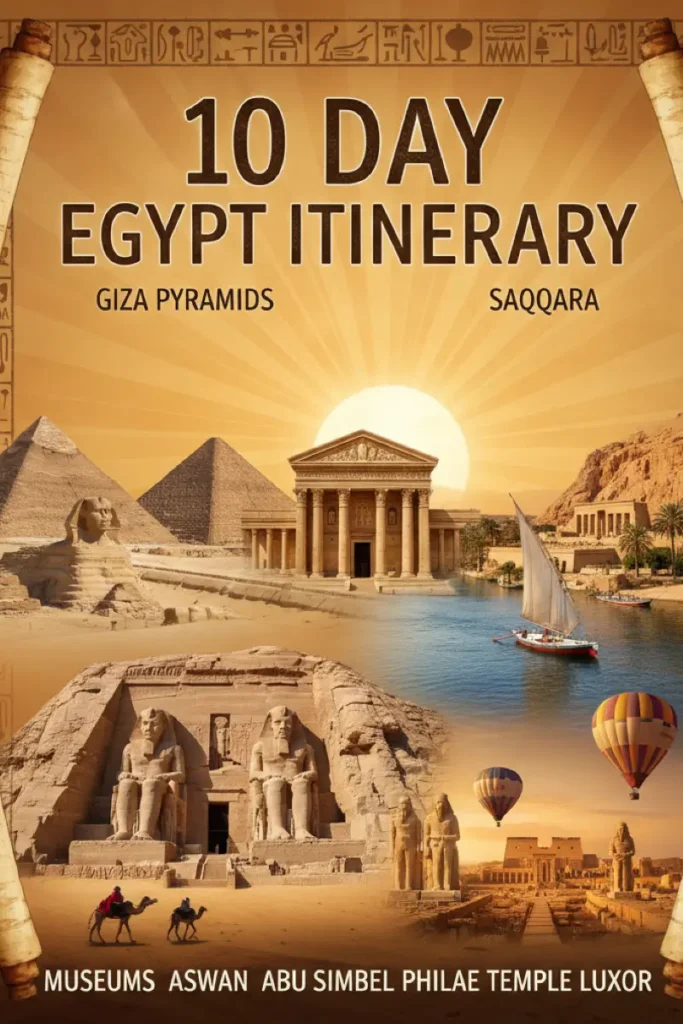
Introduction: Why Egypt Deserves Your Bucket List Spot
So you’re thinking about Egypt, huh? Trust me, you’re not alone! This incredible country has been calling out to travelers for literally thousands of years, and honestly, once you experience it yourself, you’ll totally get why. There’s something absolutely magical about standing next to a 4,500-year-old pyramid or cruising down the same Nile River that pharaohs once sailed.
Here’s the thing, though – planning an Egypt trip itinerary can feel pretty overwhelming. I mean, where do you even start? After spending several weeks exploring this amazing country (and making plenty of rookie mistakes along the way), I’ve put together this ultimate 10 day Egypt itinerary that’ll help you hit all the must-sees without losing your mind.
What makes this guide different? Well, I’m not just throwing together a generic Egypt itinerary. This is based on real experiences from dozens of travelers – solo adventurers, families with kids, history buffs, and even folks who were nervous about safety. We’re going way beyond just telling you what to see. I’ll share the insider tricks that’ll help you skip lines, avoid tourist traps, and actually enjoy your trip instead of stressing about logistics.
Plus, I’ve made sure everything here is easy to find and follow – perfect for when you’re frantically googling “Egypt travel tips” at 2 AM while planning your adventure!
Part 1: Egypt Essentials – Your Pre-Trip Planning Hub
Before we dive into the fun stuff, let’s tackle all those practical questions that keep you up at night. Trust me, getting this stuff sorted up front will make your actual trip so much smoother.
1.1 Best Time to Visit Egypt: Beating the Heat & Crowds
Okay, let’s talk weather because this is HUGE in Egypt. You definitely don’t want to be wandering around the pyramids when it’s hot enough to fry an egg on the stones (and yes, it actually gets that hot).
Your sweet spot? October through April. These months are absolutely perfect – you’ll get pleasant daytime temps that won’t leave you feeling like a melted popsicle. I’m talking comfortable 70-80°F days that are perfect for exploring those incredible outdoor sites.
Summer is a no-go, friends. We’re talking dangerously hot temperatures that can hit 122°F (50°C). That’s not just uncomfortable – it’s actually unsafe for sightseeing. I learned this the hard way during a July visit that left me hiding in air-conditioned cafes by 10 AM.
Peak season reality check: December offers the most gorgeous weather, but it’s also when everyone else has the same brilliant idea. Expect crowds and higher prices.
My insider tip? Aim for October or March-April. October’s especially sweet because you get those cooling temperatures without the November-December tourist rush. Plus, March and April are fantastic if you’re planning to hit the Red Sea for some diving or beach time.
| Month | Temperature | Crowds | Best For |
|---|---|---|---|
| Oct-Nov | Perfect | Moderate | Everything |
| Dec-Feb | Cool & Ideal | Heavy | Temples & pyramids |
| Mar-Apr | Warm & nice | Light | Water activities |
| May-Sep | Way too hot | Minimal | Air-conditioned museums only |
1.2 Visa & Entry Requirements: Your Gateway to Ancient Lands
Alright, visa talk – not the most exciting part, but super important! Most of us need a tourist visa for up to 30 days, so here’s how to make it painless.
You’ve got two options:
Option 1: Get it on arrival – Pay $25 USD cash (and it HAS to be USD cash, no cards, no other currencies) at the airport. Look for the “BANK OFFICE” sign before you hit immigration. Easy peasy, but you might wait in line.
Option 2: Apply online – This is honestly the smarter move. Use the official Visa2Egypt portal (just Google it, but watch out for fake visa websites – they’re everywhere). Apply at least 7 days before your trip since approval can take up to a week. It’ll save you time and hassle at the airport.
Quick note: Some lucky folks from places like Bahrain, Kuwait, and Saudi Arabia can just waltz in visa-free. Others (looking at you, India, Indonesia, Philippines) need to apply through an embassy ahead of time. Check your specific country’s requirements!
1.3 Money Matters & Tipping Culture: Navigating Egyptian Transactions
Let’s talk money – specifically, how not to get ripped off and how to navigate Egypt’s huge tipping culture without going broke.
Currency 101: The Egyptian Pound (LE) is official, but honestly, USD and EUR work great for touristy stuff. You’ll want a “wedge” of cash, though – Egypt’s still pretty cash-heavy.
ATM strategy: Hit up ATMs at airports or hotels for Egyptian pounds. And here’s a pro tip – get small bills (1, 5, 10 LE notes) because you’ll need them constantly for tips and bathroom fees (yes, that’s a thing).
The tipping game (“Baksheesh”): Okay, this is huge in Egypt. We’re talking about a massive tipping culture where pretty much everyone expects something. Don’t stress, though – here’s your cheat sheet:
- Drivers: $2-4 per day
- Restaurant servers: 10-15%
- Tour guides/cruise staff: $4-6 per day per person
- Guards (for photos): 50-100 EGP or $2-4
- Bathroom attendants: Small change
- Random “helpers”: Use your judgment, but don’t feel obligated
Haggling 101: It’s expected and actually fun once you get the hang of it. Research the going rates beforehand so you don’t pay tourist prices. If someone’s being super pushy, a firm “le shukran” (no thank you) usually does the trick. Most vendors are harmless – just persistent!
Cairo travel hack: Use Uber! It’s reliable and you won’t get overcharged. Pro tip: if your driver accepts the ride but takes more than 5 minutes to reach you, cancel and rebook to avoid those annoying cancellation fees.
1.4 Health & Wellness: Staying Safe & Sound in Egypt
Let’s keep you healthy and happy throughout your Egyptian adventure!
Water rule #1: Don’t drink the tap water. It’s heavily chlorinated and will definitely mess with your stomach. Stick to bottled water with intact seals – it’s cheap and available everywhere.
Food adventures: Egyptian street food is honestly some of the tastiest stuff you’ll ever eat! Just use common sense – avoid places that look super sketchy or dirty. Taking probiotics before your trip can help prep your stomach for the culinary adventure ahead.
Pack these essentials:
- Traveler’s diarrhea tablets (trust me on this one)
- Probiotics
- Ibuprofen and paracetamol
- Any prescription meds in original packaging with English prescriptions
- Strong sunscreen and sunglasses
- Mosquito repellent (those Nile mosquitoes are no joke)
- Hydrocortisone cream for bug bites
Sun protection is crucial – Egypt’s hot and dry climate will fry you faster than you think. Plan outdoor visits for early mornings and stay hydrated throughout the day.
Vaccinations: Nothing’s mandatory, but your doctor might recommend MMR, Hepatitis A/B, Rabies, and Typhoid. Have a chat with your GP a few weeks before traveling.
1.5 Safety & Managing Harassment: Real Talk for Travelers
Let’s address the elephant in the room – safety concerns. I get it, the media can make Egypt sound pretty intense, but here’s the real deal from someone who’s been there.
Overall safety: Egypt is generally quite safe for tourists. The reality on the ground is usually way less dramatic than what you see on the news. You’ll actually see tons of security – armed guards at tourist sites, police checkpoints everywhere – which can actually be reassuring rather than scary.
The harassment situation: This is more common than actual crime. Vendors can be super persistent (think: following you for three blocks trying to sell you a “genuine” ancient artifact). They’re usually not harmful, just really, really determined salespeople. Your best defense? Confidence and a firm “No, thank you.” Don’t feel bad about being direct.
Solo female travelers: Consider joining an organized tour or hiring a personal guide, especially for your first visit. It’s not that Egypt isn’t safe – it’s just that having local support can make the experience way more enjoyable and less stressful.
Street crossing survival: This deserves its own section because Egyptian traffic is… intense. There’s this saying that “pedestrian crossing is still an unknown matter” in Egypt, and it’s not entirely wrong! Here’s how to survive:
- Make eye contact with drivers
- Move steadily and confidently
- Don’t turn back once you start crossing
- Walk with locals as a “human shield” until you get the hang of it
- Conquer the road “piece by piece”
Photography notes: Be careful around government and military buildings – photographing them is forbidden and can get you in trouble.
1.6 Packing & Dress Code: Respecting Local Customs
Egypt’s a conservative country, but you don’t need to pack like you’re joining a monastery! Here’s how to dress respectfully while staying comfortable.
The dress code reality: Long, flowy dresses are your friend – they’re cool, comfortable, and culturally appropriate. Bring a light scarf for covering shoulders or chest when needed. You don’t need to cover your head unless you’re entering certain mosques. Just avoid showing your midriff or wearing super short shorts.
Pack these essentials:
- Wide-brimmed sun hat
- Comfortable walking shoes (you’ll be doing lots of walking on uneven surfaces)
- Light, breathable clothing
- A warm layer for air-conditioned trains or chilly desert nights
- Comfortable sandals
- Light jacket or sweater
Camera tip: Some sites charge extra for professional cameras, so check before you go if you’re bringing serious photography gear.
1.7 Getting Around Egypt: Optimize Your Travel Time & Budget
Here’s the thing about Egypt – it’s big! Distances between major cities are pretty substantial, so transportation planning is key to making the most of your egypt trip itinerary.
Flights: Fastest option for long distances. EgyptAir is reliable and includes baggage. Can be pricey but worth it if time’s tight.
Trains: Honestly, the best bang for your buck for major routes (Cairo-Aswan-Luxor-Alexandria). First class is comfy and affordable. Just a heads up – punctuality can be… flexible.
Buses: Really good and quite reliable. GoBus has nice deluxe coaches with amenities. Cheaper than flights but takes longer.
Private cars/drivers: Essential for remote spots like the White Desert. Can be costly, but sometimes it’s your only option. Book through your hotel or a reputable tour operator.
Nile cruises: The most relaxing way to travel between Luxor and Aswan. Usually 3-4 nights, includes meals, guides, and transport to sites. Totally worth it for the experience!
| Transport | Best For | Cost | Comfort | Time |
|---|---|---|---|---|
| Flight | Long distances | High | High | Fast |
| Train | Major cities | Low | Good | Moderate |
| Bus | Mid-range trips | Low | Good | Slow |
| Private car | Remote areas | High | High | Flexible |
| Nile cruise | Luxor-Aswan | Medium | High | Leisurely |
1.8 Independent vs. Organized Tours: Finding Your Travel Style
This is a big decision that’ll shape your whole experience. Both approaches have their perks!
Going independent: Totally doable and gives you amazing flexibility. You can beat the crowds, take your time, and save money. Just be ready to navigate, haggle, and confidently say “No, thank you” a lot.
Organized tours: Perfect for first-timers or if logistics stress you out. Everything’s handled – guides, transport, tickets. Less flexible but way less stressful.
My recommendation? A hybrid approach works great. Maybe do organized day trips for complex sites like Abu Simbel, but explore cities independently. This guide works for both styles!
Part 2: The Optimized 10-Day Egypt Itinerary – A Daily Breakdown
Alright, here’s where the magic happens! This egypt itinerary is designed to maximize your time while keeping you sane. I’ve optimized everything based on crowd patterns, travel logistics, and energy levels.
Day 1-2: Cairo & Giza – Ancient Wonders & Bustling City Life
The game plan: Hit the iconic stuff early, group nearby sites together, and use Uber to navigate Cairo’s crazy traffic.
Day 1: Arrival in Cairo & Giza Pyramids Experience
Morning/Afternoon: Land at Cairo International Airport and get settled. I highly recommend staying in Giza for those incredible pyramid views – waking up to see the pyramids from your hotel window never gets old!
Late Afternoon/Sunset: Time for the main event – the Great Pyramids of Giza and the Sphinx! Here’s the key: go as early as possible (7 AM opening) to avoid crowds and capture that stunning morning light. Should you go inside a pyramid? I’d say yes for the experience, even though there’s honestly not much to see inside. The Great Pyramid or Queen Hetepheres’ pyramid are your best bets.
Evening: Dinner with pyramid views at 9 Pyramids Lounge (book ahead and arrange transport). Consider a sunset camel ride – touristy but fun!
Day 2: Saqqara, Museums & Old Cairo Charm
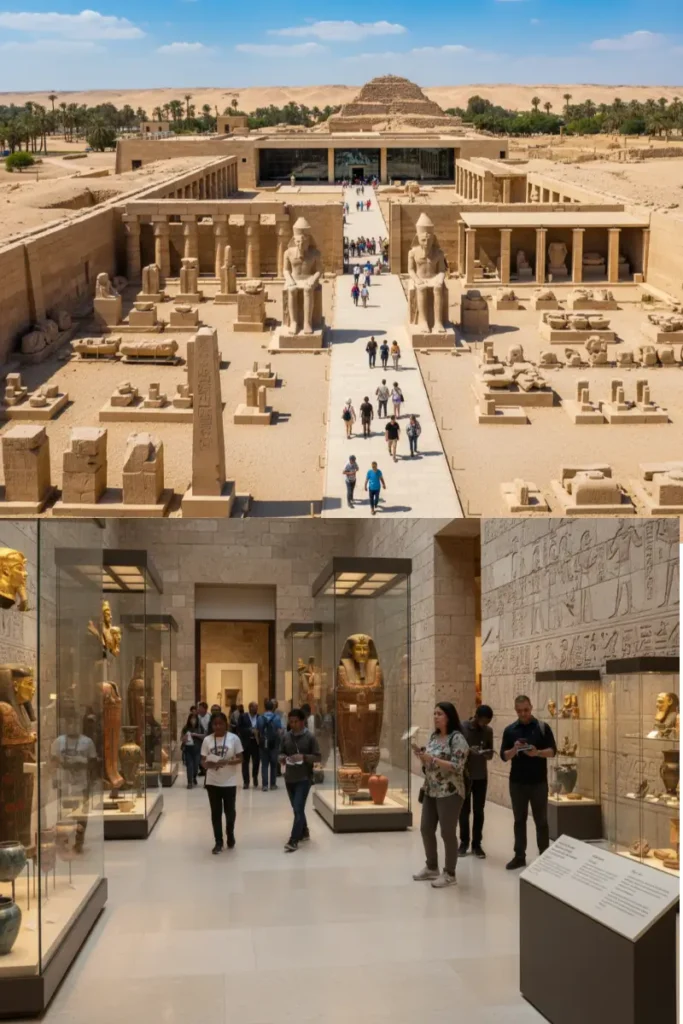
Morning: Head to Saqqara to see the Step Pyramid of Djoser – the world’s oldest pyramid! It’s way less crowded than Giza and equally impressive.
Late Morning/Afternoon: Museum time! The Grand Egyptian Museum (GEM) is incredible, with over 170,000 artifacts. The National Museum of Egyptian Civilization (NMEC) houses the famous Royal Mummies. A guide is totally worth it to understand what you’re seeing.
Afternoon/Evening: Explore Old Cairo’s Coptic Christian sites like the Hanging Church, then dive into the chaos and charm of Khan el Khalili Bazaar. Perfect place to practice your haggling skills!
Where to stay: Guardian Guest House or Marriott Mena House for pyramid views, or head to Zamalek for a quieter, more modern vibe.
Day 3-5: Aswan – Nile Serenity & Southern Treasures
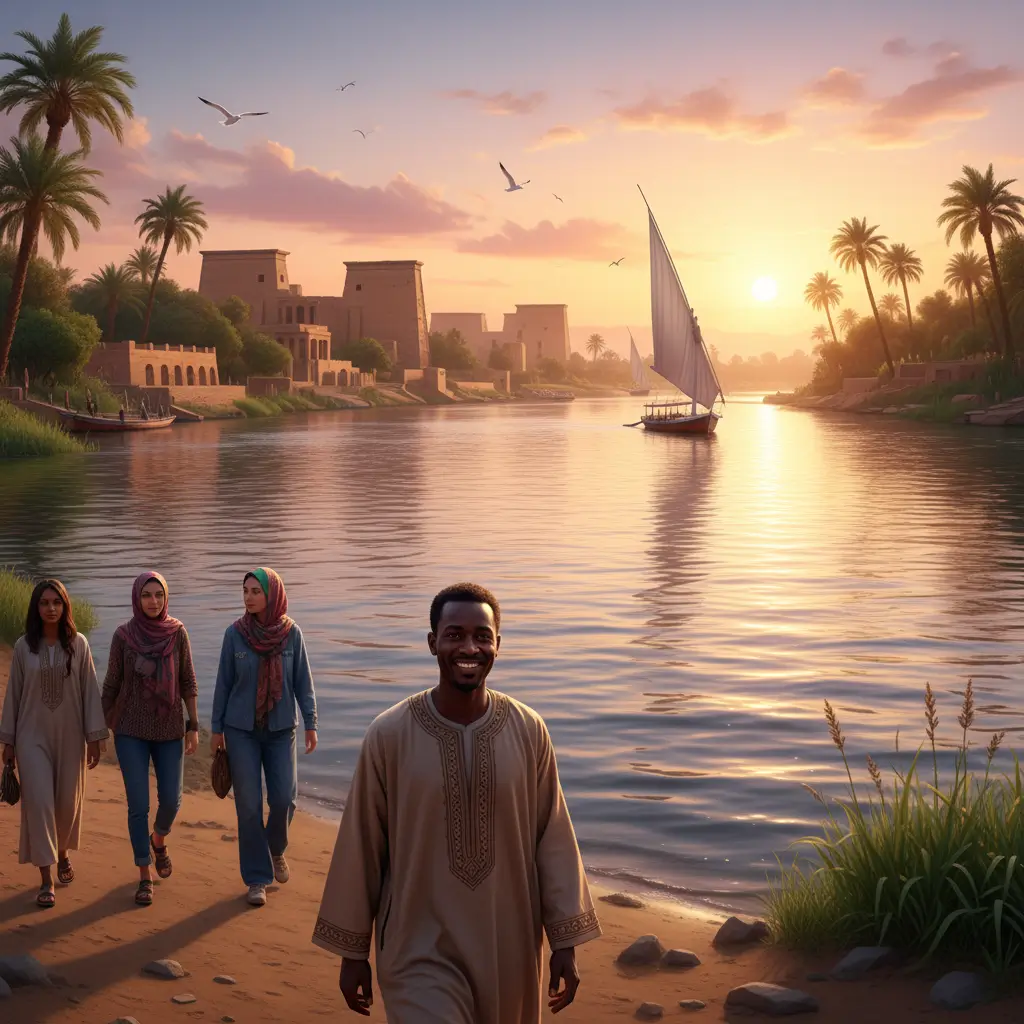
The strategy: Early start for Abu Simbel (trust me on this), then enjoy Aswan’s chill Nile vibes.
Day 3: Abu Simbel Expedition & Aswan Arrival
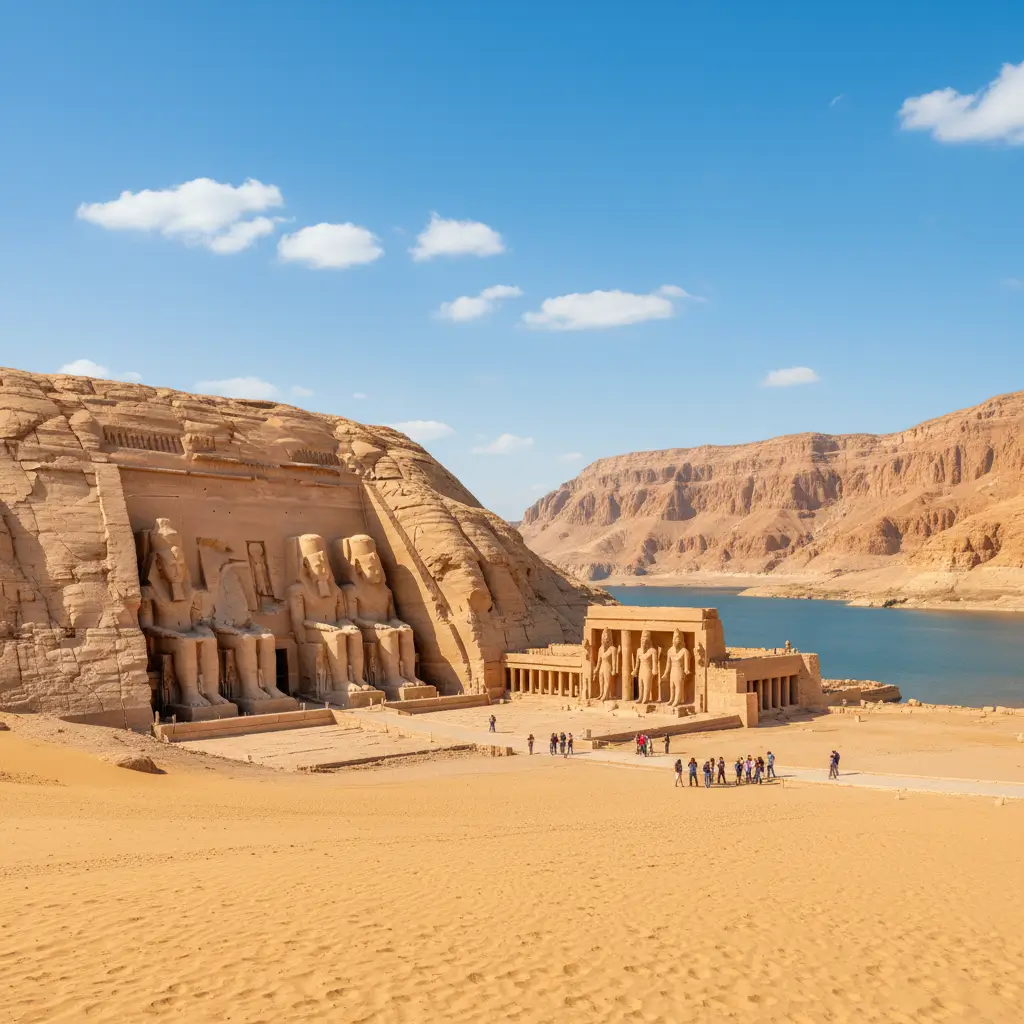
Early Morning: Abu Simbel day trip – yes, the 4 AM start sucks, but it’s 100% worth it! These massive rock-cut temples of Ramesses II are absolutely mind-blowing. The shared minivan ride (about E£1,500 for two people) is pretty standard.
Alternative: Leave around 8 AM to arrive after the early crowds have moved on – sometimes this works better!
Late Afternoon: Back to Aswan to settle in, then enjoy a relaxing sunset felucca ride on the Nile. Pure magic.
Day 4: Philae Temple, Nubian Village & Aswan’s Engineering Marvels
Morning: Philae Temple dedicated to Isis. You’ll take a short boat ride to reach it, and here’s a cool fact – this entire temple was moved stone by stone when the Aswan Dam was built!
Late Morning: Check out the Unfinished Obelisk (fascinating glimpse into ancient construction) and the Aswan High Dam – quite the engineering feat that created Lake Nasser.
Afternoon: Visit a colorful Nubian Village. The houses are Instagram-worthy, the handicrafts are beautiful, and the tea is perfect.
Evening: Nubian Museum for cultural context and gorgeous artifacts.
Day 5: Aswan to Luxor – Temples En Route
Morning: Start your journey to Luxor by private car or cruise ship. This route lets you stop at incredible temples along the way.
Mid-morning: Kom Ombo Temple – unique because it’s dedicated to two gods (Sobek the crocodile god, and Horus). Don’t miss the crocodile mummies in the nearby museum!
Afternoon: Edfu Temple (dedicated to Horus) – one of Egypt’s best-preserved temples and absolutely stunning.
Late Afternoon: Arrive in Luxor and soak in this incredible open-air museum of a city.
Where to stay in Aswan: Sofitel Legend Old Cataract for luxury, Tolip Aswan for great Nile views, or budget options on Elephantine Island like Baba Dool.
Day 6-7: Luxor – The World’s Greatest Open-Air Museum
Luxor is divided by the Nile into the East Bank (city of the living) and the West Bank (city of the dead). Smart planning makes all the difference here!
Day 6: Luxor’s East Bank – City of the Living
Early Morning: Karnak Temple Complex – the largest ancient building complex in Egypt. Get there by 8 AM for about an hour before the tour groups arrive. The Great Hypostyle Hall will blow your mind with its massive columns.
Late Afternoon/Evening: Luxor Temple is magical at sunset or after dark when it’s all lit up. The contrast between day and night visits is incredible.
Optional Evening: Karnak’s Sound & Light Show if you’re into that sort of thing.
Day 7: Luxor’s West Bank – City of the Dead
Pre-Dawn (Optional but Amazing): Hot Air Balloon ride over the Valley of the Kings at sunrise. It’s pricey, but honestly, a once-in-a-lifetime experience. Book in advance!
Morning: Valley of the Kings time! Your standard ticket includes 3 tombs. I recommend Ramesses IV, Merenptah, and Ramesses III. Tutankhamun’s tomb requires an extra ticket but it’s pretty special.
Late Morning: Hatshepsut’s Mortuary Temple with its unique three-level design and amazingly preserved colors.
Afternoon: Quick stop at the Colossi of Memnon – two massive seated statues that are perfect for photos.
Where to stay in Luxor: Pavillon Winter Luxor or Sofitel Winter Palace for luxury, Sweet Hostel for budget. Most hotels are on the East Bank, but West Bank guesthouses offer a quieter experience.
Day 8-10: Choose Your Own Adventure Ending!
Here’s where you get to customize based on what you’re craving after a week of incredible history!
Option A: Red Sea Relaxation & Diving (Hurghada/El Gouna/Dahab)
Perfect if you’re feeling templed-out and ready for some beach time!
Day 8: Travel to the Red Sea (4-hour drive from Luxor or quick flight). Check into your resort and immediately start decompressing.
Day 9: Snorkeling or diving in some of the world’s clearest waters! The Red Sea is famous for its incredible marine life and coral reefs.
Day 10: Final relaxation before heading home from Hurghada Airport.
Location breakdown:
- Hurghada: Resort central, great for beginners, good wreck diving
- El Gouna: The “Venice of the Red Sea,” more upscale and planned, fantastic for kitesurfing
- Dahab: Super chill backpacker vibe, famous Blue Hole for experienced divers
Option B: Western Desert Adventure (White & Black Deserts)
For those who want something completely different and otherworldly!
Day 8: Head back toward Cairo, then join a desert tour to the Black Desert and Crystal Mountain.
Day 9: Explore the incredible White Desert with its surreal rock formations. Overnight camping under some of the most incredible stars you’ll ever see.
Day 10: More desert exploration, then back to Cairo for departure.
Pro tip: You’ll need a military permit for desert travel, and temperatures drop dramatically at night, so pack accordingly!
Option C: Alexandria Day Trip & Cairo Departure
Great for history lovers who want to see Egypt’s Greco-Roman side!
Day 8: Luxor to Cairo by train or flight.
Day 9: Day trip to Alexandria by train (super cheap first-class tickets!). Explore the Catacombs of Kom el Shoqafa, Fort Qaitbey, and walk the beautiful Corniche.
Day 10: Final Cairo exploration or souvenir shopping before departure.
Part 3: Extending Your Egypt Itinerary (Beyond 10 Days)
Got more time? Lucky you! Here are some amazing add-ons:
Siwa Oasis: Add 2-3 days for crystal-clear salt lakes and olive groves in the Western Desert. It’s a massive journey (9 hours from Cairo) but unique.
More Alexandria: Spend extra days really diving into this coastal city’s rich history.
Full Nile Cruise: If you didn’t choose it before, a 3-4 night cruise between Luxor and Aswan is the ultimate relaxing way to see temples.
Dahshur & More Pyramids: Visit the Bent Pyramid and Red Pyramid – often less crowded than Giza and equally impressive.
Wrapping Up Your Egyptian Adventure
Look, Egypt is going to change you. There’s something about standing in places where people lived and worshipped thousands of years ago that puts everything in perspective. This 10 day Egypt itinerary gives you the framework, but the real magic happens when you’re actually there – watching the sun rise over the Nile, haggling in a bazaar, or sharing tea with locals in a Nubian village.
The key is being prepared but staying flexible. Use this guide as your roadmap, but don’t be afraid to take detours when something catches your eye. Some of my best Egyptian memories came from unexpected moments – like the time I ended up sharing dinner with a local family after getting lost in Aswan, or stumbling upon a hidden coffee shop with the best koshari in Cairo.
Egypt might feel intimidating from afar, but once you’re there, you’ll realize it’s just an incredibly rich, complex, and welcoming place filled with people who are genuinely proud of their incredible heritage and happy to share it with visitors.
So pack your sense of adventure, bring your curiosity, and get ready for the trip of a lifetime. Ancient Egypt is waiting for you, and trust me – it’s even more amazing than you’re imagining right now.
Ready to start planning your unforgettable Egyptian adventure? Your pharaoh-worthy journey begins now!

